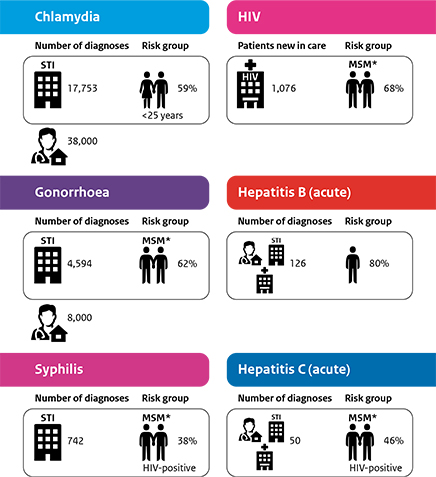
The number of clients tested for sexually transmitted infections (STIs) at Dutch STI clinics has increased since 2004. The percentage of clients with at least one STI (chlamydia, gonorrhoea, syphilis, hiv, hepatitis B) increased from 12.3 per cent in 2004 to 15.5 per cent in 2014. General practitioners, who carry out the majority of STI consultations in the Netherlands, report a similar upward trend. As in previous years, chlamydia was teh most frequently diagnosed STI, according to the RIVM report 'Sexually transmitted infections including HIV, in the Netherlands in 2014’.
In 2014, the total number of consultations at the STI clinics
was 141,191; an increase of 6 percent over 2013. The
percentage of clients diagnosed with at least one STI was higher in 2014 (15.5
per cent) than in 2013 (14.7 per cent). In 2014, this percentage
was highest among persons who had been notified of their
possible STI exposure by a (former) partner and
among known HIV-positive men who have sex with men
(MSM).
Chlamydia
The percentage of STI clinic attendees diagnosed
with a chlamydia infection increased from 11.8 per cent in
2013 to 12.6 percent in 2014 (17,753 diagnoses). The largest
increase was observed among heterosexual men (from 12.8 percent in
2013 to 13.9 percent in 2014). Chlamydia was primarily diagnosed in
women and in heterosexual men below 25 years of age (15.6 per cent
diagnosed with chlamydia). The percentage of positive tests
among MSM has been stable at around 10
percent for years.
Gonorrhoea
The percentage of STI clinic attandees with a
gonorrhoea infection has remained stable since 2012. In 2014, the
overall percentage of positive tests was 3.6 per
cent (4,594 diagnoses). Gonorrhoea is over four
times more common in MSM than in women and
heterosexual men. Increased resistance to the antibiotics
prescribed to treat gonorrhoea infections has been observed in
several European countries, but not yet in the
Netherlands. It remains important to closely
monitor antibiotic resistance.
Syphilis
Syphilis is mainly diagnosed in MSM: 93 percent of 742 syphilis diagnoses at the STI clinics in 2014. The percentage of MSM diagnosed with syphilis slightly increased from 2.0 percent in 2013 to 2.3 percent in 2014. This increased was greatest among known HIV-positive MSM: from 5.8 percent in 2013 to 6.6 percent in 2014. Among all MSM with syphilis was 41 per cent known HIV-positive.
HIV
In 2014, the number of new HIV diagnoses decreased
by 9 percent (323 cases in 2014 versus 358 cases in 2013) at the
STI clinics. Almost 90 per cent of the HIV infections
were diagnosed in MSM. The percentage of new
HIV diagnoses decreased from 3.0 percent in 2008
to 1.1 percent among MSM in 2014. The number of new
HIV diagnoses at the Dutch HIV treatment centres also
declined (from 1,311 in 2008 to 992 in 2013).
